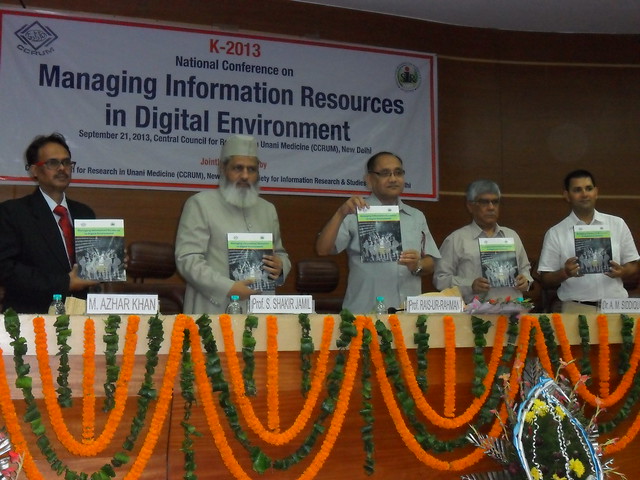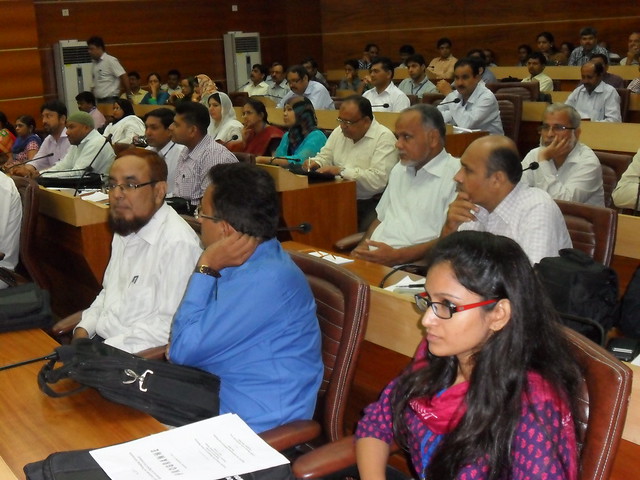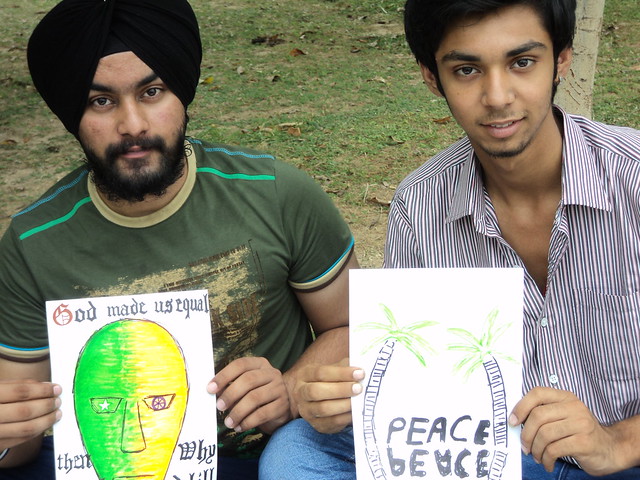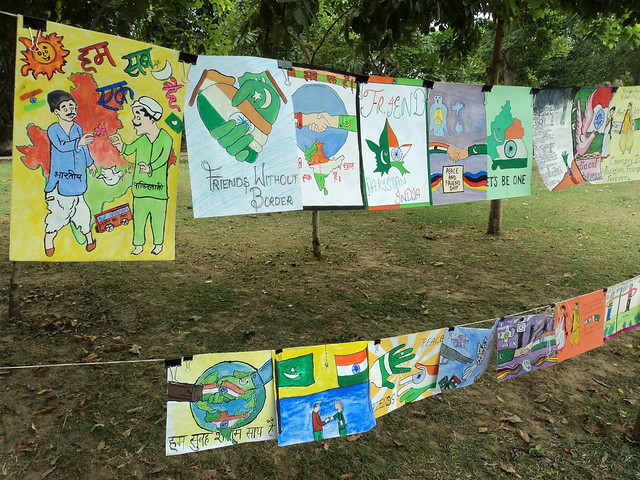By Habib Siddiqui,
Recent rise of Gujarat Chief Minister Narendra Modi to the Bharatiya Janata Party’s (BJP) core team as he become member of Central Election Committee and his subsequent nomination as the party’s Prime Ministerial candidate has left his supporters enthralled but many more worried. Modi has been seen more in Delhi than in Gandhinager, he has been speaking more Hindi than Gujarati which shows he wants his office to be shifted to Delhi.
Modi's rise in BJP has been attributed to his back to back election victories in Gujarat, he has emerged as a ‘savior’ of India from çorrupt’ Congress.
Not everyone is jubiliant on Modi's rise. It is a fact that you cannot make every one believe in the same thing, but democracy is all about making consensus and altering, modifying and changing things to try to create a consensus. Modi has been seen as a polarizing figure, for some he is a hero who can save this country from the corrupt and bad governance of UPA and for some, he is a person, who can marginalize them or worse go after their security. There exist vast amount of material to support his development agenda, efficiency of the governance and professionalism, so lets not add one more document into the pleothora and rather, I would like to give a perspective why he is being so vigorously and vehemently opposed by some, even though it is believed to have been so successful in his state of Gujarat in terms of development and growth.
It is indisputable that Modi enjoys formidable support among Indian youth, the reason for which has more to do with bad governance of UPA than good governance of Modi or his ideologies. It will be tenacious task for for him and as well as for BJP to convert this support which is extremely hard to measure before going for ballot box, into an election victory. It will be difficult because the people are supporting him due to inefficiency of the Congress but to change the result he will have to make people believe and agree with his ideology. Still going with the hysteria and cacophony, we may say that he is 'the most popular leader' for the BJP and must get his share of national political stage, as the BJP chief Rajnath Singh pointed out. Then the question arises, why there exists a part of the society which is trying by its tooth and nail to prevent him from national politics or the politics all together.
The answer to that question comes from his actions and inactions, from his spoken and unspoken words. BJP is a national party which derives its ideology from Sangh Parivar whose role in demolition of centuries old Mosque is as discerning as black and white. The sister organization of Sangh, RSS, VHP and Bagrang Dal have been many times accused of instigating, propagating and abetting communal riots across the nation, number of times their members have been convicted of these charges and many of their loosely bound organizations have recently been charged with terrorism. The top leader of BJP, Mr. LK Advani, who opposed appointment of Modi on the key position and reasoned that, it will not help party because of his polarizing image, has been indicted by Liberhan Commission into Babri Masjid demolition.
But it is not all about BJP, though BJP does not share any love with Muslim community, community has not come out with such a decisive will and opinion about the party but addition of Narendra Modi has certainly shifted opinions of Muslims far away from them. The shift of opinion comes from Narendra Modi's personality, which has certain specific traits, some of which he carries with great confidence, which includes, poster boy of development, roll model of good governance and youth icon etc. But there are few notions of his image which pose a great challenge for BJP and to him. The second category of colors of his image create a wide chasm between his supporters and his opponents. These can be named as, strong pro hindutva leader, closeness by Sangh Parivar and his response to Gujarat Riots of 2002. On the question of development, progress and governance he can create a consensus but the equation does not end there, the later parts create problems and shift opinions.
So, why these wearers of 'Muslim Caps' as Chetan Bhagat refers them to, oppose with so much zeal, a leader who is so competent to become prime minister. The answer lies, in his image, the spoken and unspoken things and things which were done and also things, which were not done. I can point things from his handling of Gujarat riots, his statements, his actions and inaction which prove he does care about some but show apathy to some or even worse conspires with people who commit genocide.
Following are my reasons for opposing him:
1. The riots exploded and carefully propagated by the incident of Godhra. Narendra Modi, released a message on Door Darshan in which he described the incident with great passion, and requested people to maintain law and order. He promised that complete legal actions will be taken against those who are guilty and even went on to say, "An example will be set, so that nobody in future dreams to do such heinous act". I accept his anger, because 56 citizens of his state were burnt alive by criminals, and I also applaud his responsible and sensible address to his people to maintain calm and peace. But after Godhra, there were number of massacres, just under the nose of control rooms but Modi failed to give any such address to his state. He was still a CM of every person of his state and this was his 'Raj Dharma' as Vajpayee the PM at that time mentioned, to come again on TV and say, 'even now I will set an example, so that nobody in future dreams of committing acts like masscare in Naroda Patia, Gulbarg socieity and many other places'. He failed to give assurances and sense of security to those affected in the riots.
Why he did not condemn those acts with the same passion and emotions. Clearly he saw his citizens with two eyes. Some were closer to him than others, some were more important to him than others, few drops of blood was dearer to him than others. He was partial in his response without any doubt.
2. Gujarat government declared a compensation of 200,000 rupees for the people burnt in Sabarmati Express and 100,000 for the people killed in riots. This was gross misconduct of CM and betrayed his sympathy towards few and his apathy towards some. Later because of the hue and cry from citizens of India the government managed to revised the compensation to 150,000. No amount of PR activity or explanation can absolve these crimes of partiality when it was clear the worst affected were the people of riots and not the burning of the trains. Modi showed his true face with his action.
3. The partiality does not end here, 131 accused of Godhra train burning were charged with POTA, equating the a criminal act by act of terrorism and waging war against nation. POTA was thrown away from the case by both Gujarat high court as well as Supreme Court of India. It was very clear that Modi was on the path of 'setting an example'. But his 'professional and efficient administration' did not do the same with any accused of riots. This was clearly double standard adopted by Gujarat administration, the responsibility of which does go to Narendra Modi.
4. In response to the Godhra carnage, VHP the 'pacifism' and 'kind heart' of whose is known to every one called for Gujarat Bandh which was supported by Modi. The Bandh actually acted as fuel for the riots in the days to come. It clearly allowed people conspire, group and 'vent their anger' against innocent civilians. Why Mr. Narendra Modi, did not behave with more prudence and competence and with his all influence on VHP requested them to cancel the bandh.
5. Many mosques and dargahs were destroyed in riots, restoration of these were serious questions. The tomb of the eighteenth century saint, Wali Gujarati was leveled and paved over by road, the following day by the council. As these shrines were destroyed in riots Gujarat government had every responsibility to help in the restoration but the government actually tried to go away from citing that construction of religious places is not under the responsibility of state government and when directed by Gujarat High Court to do so, they appealed against the judgement in Supreme Court which reminded Gujarat government that restoration of damaged religious places, is not act of 'appeasement' as BJP likes to put it, rather it is responsibility of state government to do so. I think shying away from this responsibility and showing apathy towards Muslims in a situation where they felt most insecure, was gross breach of trust of the whole community.
6. The carnage left many people homeless and as the pogrom progressed these internal refugee numbers swell. . The official number of internally displaced people was 1.09 lakh and unofficial accounts said, it was 2.5 lakhs. These displace people were living in 101 relief camps set up by Muslim community with the help of NGOs and assisted by State government. Not even a single camp was set up by state government. Even worse, NGOs and camp organizers allege that about 100 such relief camps, were never recognized by the state government for the assistance. It was duty of Narendra Modi to assuage the pain of the people by proper rehabilitation, compensation and moral support. But he looked the other way and tried to find ways to circumvent his duty.
7. BJP and Modi supporters have always defended Modi from criticism of national NGOs and have many times labled them as being pro Congress and biased towards them, many human right activists are branded as paid by congress, by general BJP sympathizers. So, lets leave national NGOs and Human Right Organization and go to the international organizations which cannot come under the mighty influence of Congress. Among-st the most respected international organizations for Human Rights is Human Rights Watch (HRW) and it produced in depth report on the 2002 riots and criticized the state government, state police, BJP, VHP and RSS. The report can be found at http://www.hrw.org/reports/2002/india/. The HRW published follow up report ten years later http://www.hrw.org/news/2012/02/24/india-decade-gujarat-justice-incomplete, which accused state government of taking different stands on crimes of Godhra and aftermath of Godhra. Gujarat government received similar harsh criticism from Amnesy International as well.
8. On the top of everything, sting of operation of Tahelka, conducted by Ashish Khetan explained the riots bit by bit by the criminals themselves. Based on Tahelka tapes Maya Kondnani was sentenced to 28 years in prison in a Naroda massacre. One should not forget that she was women and child development minister in Modi government. In her judgement, Hon'bl Justice Geeta Johri said that she received help of government and efforts were made to avoid her name appearing on list of accused. It was also noted by Hon'bl court that she was favored by investigating team before SIT. Court also criticized police for not policing in riots and deliberately conducting poor investigations.
Tahelka sting operation was otherwise very carefully overlooked by Modi and his administration. Investigative agencies with such huge amount of information and unforced confessions failed to bring about strong cases against criminals, and against Modi. I can accept that people in the tape may have over stated or boasted about the scale of their actions but conformity of information, independently coming out from different people was a strong evidence of their involvement and complicity of Modi in the violence. This was gross failure on the part of Modi.
A lot of time has passed, more than eleven years since the carnage began, it is said, 'time heals everything'. BJP has argued that Congress has successfully seeded idea of Modi and BJP being anti Muslim in the minds of Muslims. I accept there exist a serious effort from Congress to paint BJP and Modi as being pro Hindutva and anti Muslim but it is absolutely not true to say that Musims have just accepted the Congress's narrative without their own cognitive assessment. Specially, Modi being anti Muslim is widely accepted among st Muslim community quite independently and across the various factions of the community. Modi being a mature politician with all his PR activities have failed to gain considerable acceptance with Muslims. There exist a serious question, why after more than eleven years of massacre, he failed to get support of Muslims. The answer for that lies in his character which never allowed to him to go to the Muslims. His approach towards Muslim community does not go hand in hand with his trait of hard line hindutva leader and may be this trait of him is dearer to him than the community of Muslim itself.
I have lead my argument through facts and very strong established evidences, I have refrained from mentioning anything which is contentious, for example the comment of 'action and reaction', even Mr. Vajpayee's comment about 'Raj Dharma'. These are my reasons to believe that Narendra Modi behaved in most unprofessional way in handling the riots, he failed to give Muslim assurances in similar ways he gave to others, he supported activities which proved to be detrimental for the peace and harmony of the state, he carefully sidelined many of his duty.
Mr. Ranjnath Singh and Sri Sri Ravishankar, can always say that Muslims should forget about 2002 because its very easy for them to say as no one from their family have been burnt, hacked, raped or looted. These people should restrain their tongues as they are public figures, their comment hurt many who are still denied justice.
(Habib Siddiqui works in Doha, he can be reached at habib872@gmail.com)













